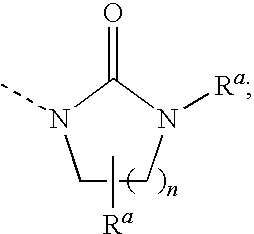Heterocyclic Non-Peptide GNRH Antagonists
a peptide antagonist and heterocyclic technology, applied in the field of compounds, can solve the problems of limited effectiveness as drugs, high cost, and high cost of current peptide antagonists, and achieve the effect of being useful in cancer therapy or
- Summary
- Abstract
- Description
- Claims
- Application Information
AI Technical Summary
Benefits of technology
Problems solved by technology
Method used
Image
Examples
example 1
2-(3-tert-butylphenoxy)-N-(4,6-dimethoxy-2-(3-morpholinopropylamino)pyrimidin-5-yl)oxazole-4-carboxamide
[0341]To a cooled (−30° C.) solution of 4,6-dimethoxy-N-(3-morpholinopropyl)pyrimidine-2,5-diamine (prepared according to the procedure in WO-A-02 / 098363; 1.09 g, 3.67 mmol) was added dropwise a solution of trimethylaluminium (2 M solution in toluene, 5.5 ml, 11 mmol) and the resulting mixture was allowed to warm to −20° C. over 30 min and then to room temperature over 45 min. This mixture was then added dropwise to a cooled (0° C.) solution of ethyl 2-(3-tert-butylphenoxy)oxazole-4-carboxylate (Intermediate 1, 530 mg, 1.83 mmol) in dichloromethane. The resulting mixture was allowed to warm to room temperature over 30 min and then heated to 40° C. for 16 h. Upon cooling the reaction was then quenched with saturated aqueous ammonium acetate (30 ml, CARE EXOTHERM). The aqueous phase was separated and then extracted with ethyl acetate (4×25 ml) and the combined organic extracts were ...
example 2
2-(3-tert-butylphenoxy)-N-(4,6-dimethoxy-2-(3-morpholinopropylamino)pyrimidin-5-yl)thiazole-4-carboxamide
[0342]Prepared according to the method directly above for Example 1 from ethyl 2-(3-tert-butylphenoxy)thiazole-4-carboxylate (Intermediate 2) and 4,6-dimethoxy-N-(3-morpholinopropyl)pyrimidine-2,5-diamine (prepared according to the procedure in WO-A-02 / 098363) with the exception that the final reaction mixture was allowed to stir at room temperature for 60 h. Work-up and purification as described afforded the title compound (50%). M.p. 68° C., Rf 0.32 (19:1 dichloromethane-methanol). 1H NMR δ 7.84 (1H, s), 7.60 (1H, s), 7.20-7.32 (3H, m), 7.05-7.8 (1H, m), 5.68 (1H, br, m), 3.79 (6H, s), 3.66-3.69 (4H, m), 3.37-3.42 (2H, m), 2.38-2.45 (6H, m), 1.65-1.75 (2H, m) and 1.26 (9H, s); m / z 557.2 (MH+).
example 3
2-(3,3-dimethyl-2,3-dihydro-1H-inden-5-yloxy)-N-(2-(2-(dimethylamino)ethylamino)-4,6-dimethoxypyrimidin-5-yl)oxazole-4-carboxamide
[0343]The title compound was prepared according to the method outlined in Example 1 from N-(2-(dimethylamino)ethyl)-4,6-dimethoxypyrimidine-2,5-diamine (Intermediate 4) and ethyl 2-(3,3-dimethyl-2,3-dihydro-1H-inden-5-yloxy)oxazole-4-carboxylate (Intermediate 6) with the exception that after aqueous work up the crude compound was purified first by cation exchange (Argonaut MP-TsOH, elution 2 N ammonia in methanol) and then by column chromatography (SiO2, elution 19:1-dichloromethane-methanol and 0.5% ammonia). The title compound was isolated as a yellow glass (11% yield). Rf=0.10 (1:9-methanol-dichloromethane with 0.1% 0.88 aqueous ammonia solution). 1H NMR δ 7.82 (1H, s), 7.44 (1H, broad s), 7.14-7.16 (1H, m), 7.04-7.07 (1H, m), 6.98-6.99 (1H, m), 5.30 (1H, br, t), 3.79 (6H, s), 3.38 (2H, q), 2.83 (2H, t), 2.42 (2H, t), 2.20 (6H, s), 1.91 (2H, t) and 1.2...
PUM
| Property | Measurement | Unit |
|---|---|---|
| Mass | aaaaa | aaaaa |
| Molar density | aaaaa | aaaaa |
| Molar density | aaaaa | aaaaa |
Abstract
Description
Claims
Application Information
 Login to View More
Login to View More - R&D
- Intellectual Property
- Life Sciences
- Materials
- Tech Scout
- Unparalleled Data Quality
- Higher Quality Content
- 60% Fewer Hallucinations
Browse by: Latest US Patents, China's latest patents, Technical Efficacy Thesaurus, Application Domain, Technology Topic, Popular Technical Reports.
© 2025 PatSnap. All rights reserved.Legal|Privacy policy|Modern Slavery Act Transparency Statement|Sitemap|About US| Contact US: help@patsnap.com



